The sight of 109 baby strollers abandoned in the central square of the Ukrainian city of Lviv in March, 2022, left a lasting impression on Shyu Ruey-shiann (徐瑞憲), inspiring him to create Between II (之間II), a large-scale installation currently on view at the Taipei Fine Arts Museum (TFAM).
Each stroller activates a sound, be it a shell exploding, the cries of child or the voice of someone afflicted by the conflict in Ukraine telling their story.
Shyu’s work is among four exhibits on the museum’s third floor, which run until Oct. 20. Although the range of approaches are very different, themes of identity and belonging pervade the exhibit halls.
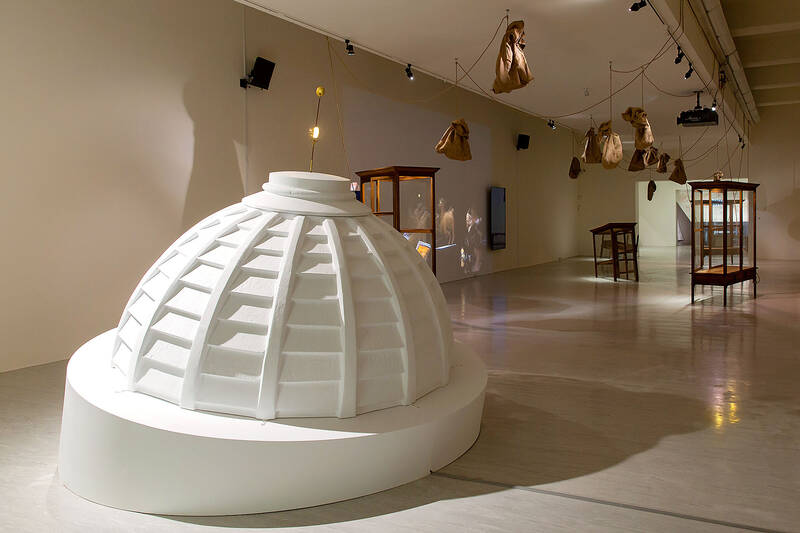
Photo courtesy of TFAM
SOLIDARITY WITH UKRAINE
Although Between II is somewhat bewildering at first glance — a gallery space filled with baby strollers — once you push one of the strollers, the artist’s message becomes apparent.
Shyu combines the field recordings he made in Ukraine with wall graffiti written by Ukrainians describing the Russian invasion that has destroyed much of their country.
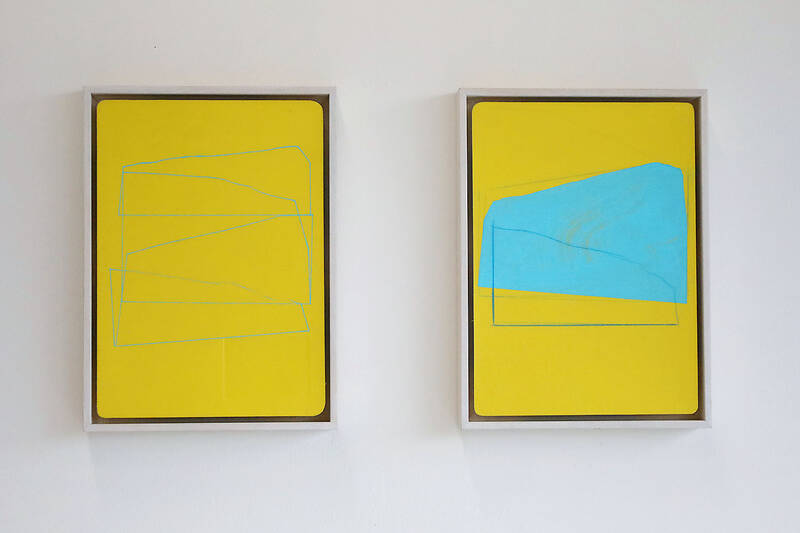
Photo: Thomas Bird, Taipei Times
One line expresses the hopelessness they feel: “Sometimes you just get used to sirens,” it reads.
Despite creating a deeply symbolic installation, it doesn’t get more real than this.
LINES IN THE SAND
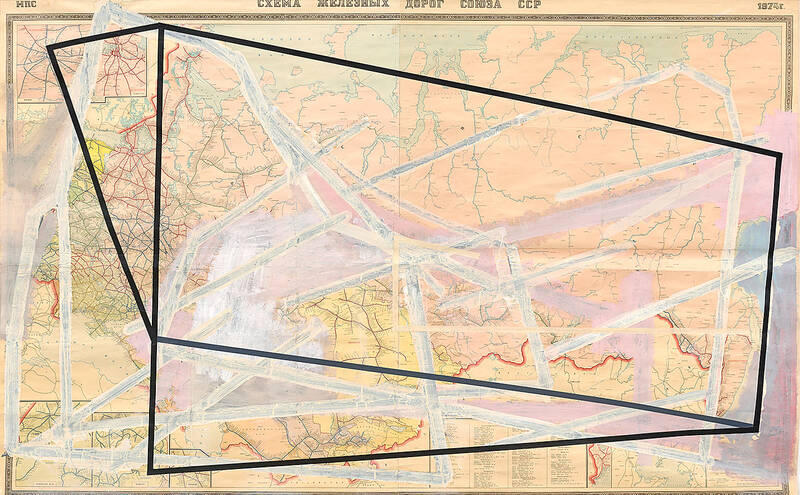
Photo courtesy of TFAM
Taipei-born, Germany-based Chen I-shu’s (陳以書) exhibit Fake Landscapes (假山水) also includes references to the war in Ukraine.
Chen asserts that as a Taiwanese artist, he must confront his identity, not only artistically or culturally but also politically and historically.
This concern inevitably draws parallels with the Ukrainian experience.
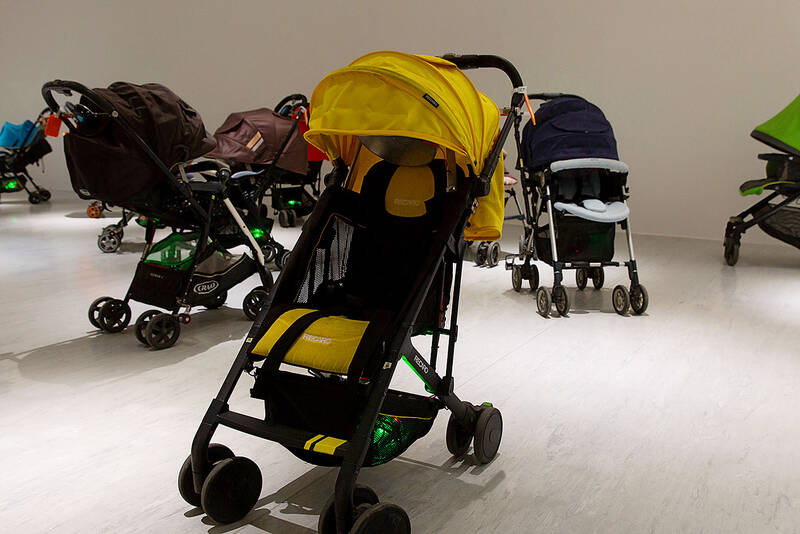
Photo courtesy of TFAM
The result is Hommage a Ukraine (向烏克蘭致敬) — six works that distort and subvert the color scheme of the Ukraine flag.
Opposite, Chen redraws the map of Russia by painting lines and sticking tape on an old map of the USSR in a work he’s titled Divided Empire (分裂的帝國).
These are potent creations, which, like the work of Shyu, have special resonance for Taiwanese visitors to the museum.
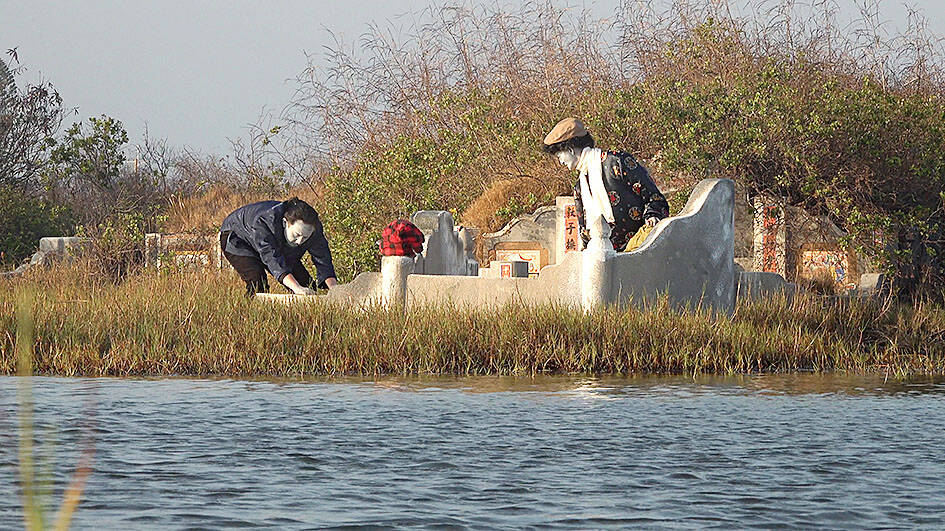
Photo courtesy of TFAM
However, the rest of his exhibit is dominated by large Untitled impressionist works that lack the same urgency.
These pieces are “based on the compositions of stacked rocks” and “the cross-section lines suggests the concept of real and unreal in limbo,” reads the exhibit’s introduction.
Well maybe. But the subversion of classical landscape painting has been done by more than few of Chen’s contemporaries, while he doesn’t hide the influences of twentieth-century masters (see Rothko, de Kooning or even Lichtenstein) who explored similar terrain.
OF ANIMALS AND MAN
The most unusual of the solo exhibits is by Chiayi-born Tsai Pou-ching (蔡咅璟).
Tsai has been fond of animals since childhood and his recent work “attends to human-animal relationships through his study of amateur biology.”
Specimen of Empire (帝國的標本) exhibits old images collected by the Japanese authorities who had sought to document and categorize the native fauna of its Asian colonies for The Empire of Japan Museum, a museum that never came to fruition.
Tsai resurrects their faded images and taxidermy that were abandoned at the end of World War II in order to create art from something that had hitherto belonged to science, history and empire.
By incorporating video and installation, Tsai makes these lost zoological dreams three-dimensional.
The artwork is visually arresting and somewhat haunting, as one regards animals, not in the light of scientific documentation, but in the shadows of modern history and the amnesia that accompanies regime change.
However, Tsai’s stated aim of exploring “contemporary survival modes and progressively complex relationships with animals,” is a tad intellectually lofty and, frankly, vague.
GETTING OLD
Ni Hsiang (倪祥), another Chiayi-born artist, investigates Taiwan’s super-aging society with Everyone came to see you (大家都來看你了).
This radical, if rather idiosyncratic exhibit, takes two walk-throughs to make sense of, even though the topic is a pressing one.
By assembling belongings from the past — including kitschy memorabilia, familiar heirlooms, relics from pre-democratic Taiwan and trash — Ni creates sculptures of people’s lives out of the material culture they have left behind.
There’s a satirical-comic element to the artwork — walking-frames paired with bicycle helmets that gallery visitors are invited to use; a range of soaps leading to an empty shower; a video beamed onto some fruit boxes of a ghostly person canoeing a grave-shaped boat down a stream amidst hundreds of ancestral graves.
All express the burden of history felt by young Taiwanese tasked with supporting many old people.
Unfortunately, like Specimen of Empire this exhibit is a tad too clever for its own good and suffers from an excess of materials and media.
While ideas are plentiful, a minimalist and clear-eyed approach would make these good exhibits great.

In the March 9 edition of the Taipei Times a piece by Ninon Godefroy ran with the headine “The quiet, gentle rhythm of Taiwan.” It started with the line “Taiwan is a small, humble place. There is no Eiffel Tower, no pyramids — no singular attraction that draws the world’s attention.” I laughed out loud at that. This was out of no disrespect for the author or the piece, which made some interesting analogies and good points about how both Din Tai Fung’s and Taiwan Semiconductor Manufacturing Co’s (TSMC, 台積電) meticulous attention to detail and quality are not quite up to

April 21 to April 27 Hsieh Er’s (謝娥) political fortunes were rising fast after she got out of jail and joined the Chinese Nationalist Party (KMT) in December 1945. Not only did she hold key positions in various committees, she was elected the only woman on the Taipei City Council and headed to Nanjing in 1946 as the sole Taiwanese female representative to the National Constituent Assembly. With the support of first lady Soong May-ling (宋美齡), she started the Taipei Women’s Association and Taiwan Provincial Women’s Association, where she

It is one of the more remarkable facts of Taiwan history that it was never occupied or claimed by any of the numerous kingdoms of southern China — Han or otherwise — that lay just across the water from it. None of their brilliant ministers ever discovered that Taiwan was a “core interest” of the state whose annexation was “inevitable.” As Paul Kua notes in an excellent monograph laying out how the Portuguese gave Taiwan the name “Formosa,” the first Europeans to express an interest in occupying Taiwan were the Spanish. Tonio Andrade in his seminal work, How Taiwan Became Chinese,

Mongolian influencer Anudari Daarya looks effortlessly glamorous and carefree in her social media posts — but the classically trained pianist’s road to acceptance as a transgender artist has been anything but easy. She is one of a growing number of Mongolian LGBTQ youth challenging stereotypes and fighting for acceptance through media representation in the socially conservative country. LGBTQ Mongolians often hide their identities from their employers and colleagues for fear of discrimination, with a survey by the non-profit LGBT Centre Mongolia showing that only 20 percent of people felt comfortable coming out at work. Daarya, 25, said she has faced discrimination since she